Running through the struggle like a golden thread was the indomitable human spirit and a capacity for self-sacrifice and discipline.
– Nelson Mandela
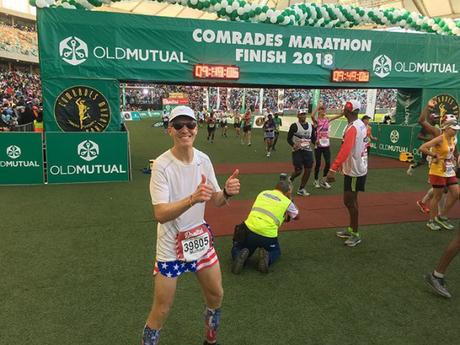
(Howdy! For those interested in a full treatment of the Comrades Marathon including its many unique and long-standing traditions, I recommend you start with my two-part report from last year’s “up” run HERE. On the other hand, if you’re basically just here for the pictures, carry on…)
“Hello, Moses.”
“I see you, Moses.”
“I am coming, Moses.”
These quiet declarations reached my ears as little more than a mumble emanating from the gaunt runner to my right. Despite my fatigue, I couldn’t help but smile. The two us strode forward slowly yet inexorably, like iron filings drawn toward the great white magnet looming directly ahead. Every step brought us closer to our ultimate destination and the object of his desire: Moses Mabhida Stadium, its central arch rising in defiance against the afternoon sky.
Despite our conspicuous outer differences — his deep ebony skin and Old World accent vs. my own melanin-challenged physique and New World English — the two of us moved as of one mind and body, eyes locked on our mutual Mecca as we approached the end of this arduous pilgrimage together. Eternal glory and an ice-cold soda beckoned.
At that moment we were kindred spirits, brothers in arms (and legs), intimate associates pulling in the same direction and with the same focused fervor for the same compulsive cause.
Or what Webster’s Dictionary would call comrades.
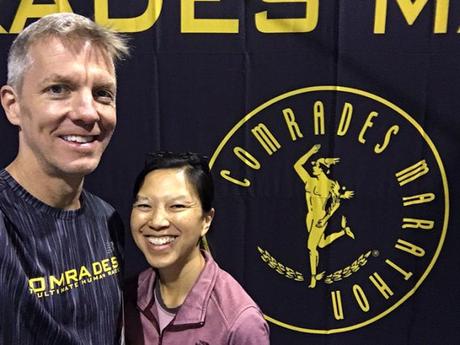
Had it really been a year?
371 days to be exact, since I’d stood in a similar position at the start line of my first Comrades Marathon, sweating incongruously in the cool morning air while the butterflies of the moment treated my stomach like children treat a bounce house.
This was like déjà vu all over again.
The scene around me now was electric — not surprising at the start line of the world’s oldest and largest ultramarathon. The collective human electricity of nearly 20,000 tightly packed runners intermingled with the harsh electric floodlights, the latter sending the pre-dawn shadows into hiding along the back alleys of downtown Pietermaritzburg.
Directly ahead at one end of the sea of heads stood the brighly lit red arch with “Bonitas” written in script letters on either side of the word “START.” The scene felt very much the same as I remembered it from a year earlier.
And yet different. Durban City Hall, which had towered over these same start corrals one year ago, had been replaced with the equally majestic brick façade of the Pietermaritzburg City Hall. This, of course, is one defining feature of the Comrades Marathon: its course reverses direction in alternating years, so that whereas last year’s “up” ran started in Durban and finished in Pietermaritzburg, this year’s “down” run would travel the opposite route, starting in Pietermaritzburg before finishing 90.184 km (56 miles) away in Durban’s Moses Mabhida Stadium.

Moses Mabhida Stadium, Durban
The familiar face alongside me was also a welcome difference from the 2017 run. IRONMAN triathlete power couple Jimmy and his wife Catherine had accepted our invite to join us for this year’s down run, with Jimmy running and Cath joining Katie in providing all-important crew support (or “seconding,” as it’s termed in South Africa). This would be not only Jimmy’s first Comrades but also his first ultramarathon, in recognition of a milestone birthday. What better way to celebrate half a century on this planet than by traveling halfway across it to run 56 miles?
Likewise Beth from Vancouver, whom we’d first met five years earlier when she’d won the half marathon in Antarctica, had decided this year’s down run would be her first Comrades and first ultramarathon in celebration of her own milestone 40th birthday. Because you’re never too old to make questionable decisions!
Beth’s husband Miguel, the only soccer player among us, would be joining Cath and a now-experienced Katie to form the day’s most bad-ass seconding crew. Having the three of them on the course armed with a beautifully detailed map courtesy of 12-time Comrades finisher Rory — another Antarctica pal and our excellent host for Comrades 2017 — gave me a huge sense of confidence. Talk about strength in numbers.
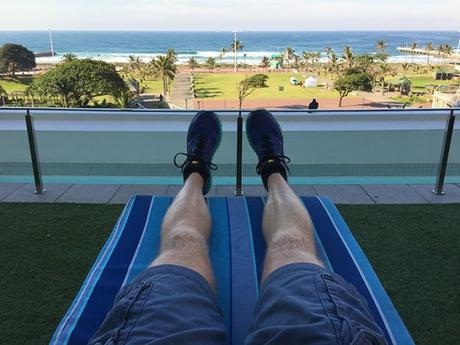
The days in Durban leading up to Comrades are just packed
Another notable distinction from the 2017 race was my nerves, or more accurately my unnerving lack of nerves. Standing in the monolithic presence of Pietermaritzburg City Hall chatting with Jimmy, I felt none of last year’s anxiety or apprehension. Sure, a lot of unknowns lay ahead on the 90 km journey to Durban, and for that the butterflies in my stomach were up to the challenge. But this time they all seemed to be flying in formation, rather than each doing its separate thing — the moment brought to mind the 80s video game Galaga, with the enemy warships all flying in formation at the start of each new screen, compared to the ensuing swarm of every ship for himself. And as the South African national anthem reached its conclusion, I felt relaxed and strangely at ease.
That said, even the best-behaved butterflies can’t help but be thrown off course by the power and beauty of what comes next: the Ndebele mining song, “Shosholoza.” Rather than observe in awestruck appreciation as other runners around me joined in the performance, though, this year I joined in myself. This despite the fact my voice was little more than a vibration in my head against the sonic wall of vocal harmonies, which resonated deep in my chest like a lion’s roar at close range.
“Shosholoza” segued predictably into “Chariots of Fire” as I made a last-second adjustment to the safety pins holding my bib number. Moments later the last notes of Vangelis’ classic score faded away, and the pregnant pause in its wake sent a few more butterflies fluttering out of formation. Adrenaline flooded my bloodstream.
Then, as loudly as if I’d been carrying a restless rooster in the lightweight pack on my back, the ear-splitting sound of Max Trumbull’s recorded cockerel crow pierced the morning quiet, signaling the start of the 93rd Comrades Marathon just as it has every Comrades Marathon for the past 71 years.
The decisive crack of a gunshot followed and with that, every one of the 19,116 starters assembled outside Pietermaritzburg City Hall — from the eventual champions in Corral A to the final finishers in Corral H — was at the mercy of the ticking clock. Because no matter our corral seeding or how long it would take us to cross under the official red START arch, we would have exactly 12 hours from the moment of that opening gunshot to cross the finish line in Moses Mabhida Stadium some 90 km away. “Gun to gun” (rather than “mat to mat”) timing is one of the signature traditions of the Comrades Marathon.
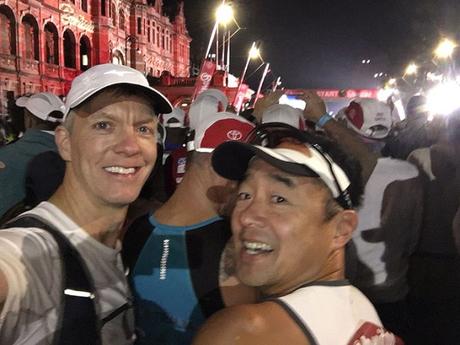
NO TURNING BACK — except for a start-line selfie
As Jimmy and I joined runners from 79 other nations in the relentless march toward Durban, I reflected on the irony of my being here after last year’s race. Comrades 2017 had left me so emotionally and physically depleted that I’d been unable to get comfortable for hours after crossing the finish line at the Scottsville Racecourse. Even my palate had hurt the next day.
But as every ultrarunner can tell you, miserable is memorable, and it wasn’t long before the siren song of the coveted back-to-back medal (earned by running the up and down runs in consecutive years) had reached my ears in Los Angeles some 10,000 miles away. And as the official Comrades Coach Lindsey Parry had pointed out at the pre-race expo three days earlier, you haven’t really run the Comrades Marathon until you’ve run both the “up” and “down” runs.
In other words, what goes up must come down. And gravity ain’t got nothin’ on Comrades.
90 km to go.
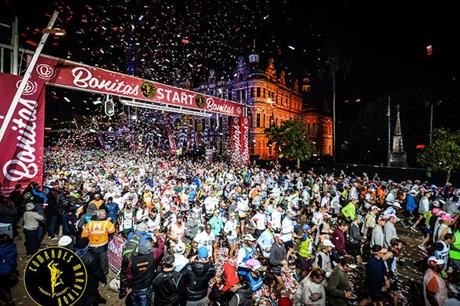
The calm before Comrades
Jimmy, Cath, Katie and I had arrived in Durban on Wednesday after back-to-back-to-back flights from Los Angeles to London, London to Johannesburg and Joburg to Durban. Based on our positive experience of the previous year, we’d again elected to stay at the Southern Sun Elangeni in coastal Durban near the pre-race expo, rather than save ourselves time on race morning by staying closer to the start line in Pietermaritzburg.
We’d taken advantage of our mid-week arrival to recover from jet lag and tackle the intimidatingly large expo at the Durban Exhibition Centre on Thursday, well before the crush of foot traffic that would descend on Friday and Saturday. (Luckily the registration line for international athletes is typically short on any day, not surprising given that South Africans account for over 90% of registered runners.)
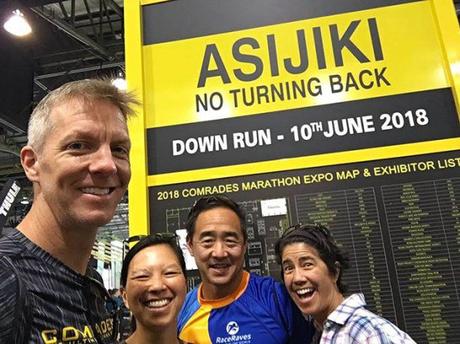
After flying 11,000+ miles, you better believe there’s no turning back (Me, Katie, Jimmy, Cath)
All manner of vendors stood alongside their booths hawking various goods and services, from athletic gear and apparel to other South African running events to Cape Town wineries and even an aggressive, aerosol can-wielding team of fellows who seemed hell-bent on shining my New Balance running shoes.
Several local charities had set up tables to raise awareness, and we sought out the Ethembeni School for physically disabled and visually impaired children — the school itself is located near the 37 km mark of the down run — to make a donation. In one corner of the exhibition center we purchased tickets for the Sunday shuttle to Pietermaritzburg, while in another a convenient food court boasted a diverse selection of lunch fare.
I could only imagine how claustrophobic this hall would feel come Saturday.
[Comrades Tip #1: The earlier you can hit the pre-race expo, the better — things start to get very busy on Friday afternoon.]
Along with the Old Mutual stage where Coach Parry shared his tips and tricks for the down run, the highlight of this year’s expo was the food court, where during lunch we met Benny and his wife Monica, an enthusiastic couple from Johannesburg. With Monica’s support, an infectious smile and an easy laugh, Benny was preparing to run his first Comrades. Nothing unusual about that, except that he’d only run his first mile a year earlier, and so was not only a novice to Comrades but to the sport itself.
Benny was clearly eager to embrace the opportunity and put his best foot forward; at the same time, he harbored no allusions as to the challenge ahead. And though in the end he’d just miss the Pinetown cutoff and be among the 13.8% not to finish this year’s race, he’d message me afterwards to say that he’d had “so much fun” and that he’d start preparing for 2019 just as soon as his “penguin walk” subsided. And I have no doubt he’ll be ready.
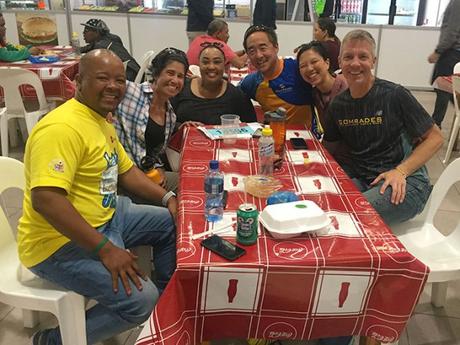
Breaking bread with Comrades first-timer Benny (left) and his wife Monica (third from left)
Because that, in a nutshell, is what Comrades does to your brain — like your favorite childhood memory, it takes hold and never lets go. I can’t imagine many Americans following Benny’s ambitious “Couch to Comrades” program. And it’s probably fortuitous that Katie and I don’t live in South Africa, because despite the distance I’d have a helluva time saying “no” to a hometown race like Comrades.
On Thursday evening we’d attended the International Runners Reception at the Hilton Durban, which this year was sparsely attended and featured an obnoxiously loud musical score that quickly drowned out every conversation I tried to start. As usual, the highlight of the reception was 9-time Comrades champ Bruce Fordyce with his waggish energy and bottomless quiver of amusing anecdotes. Everyone appreciates Bruce — he’s a magnetic personality and the best ambassador this race could ever hope for.
As it had last year, our Saturday began with thousands of our fellow Comrades runners at the packed Durban North Beach parkrun, where we’d met up with our buddy John from Anchorage, like me a returning runner chasing his back-to-back medal. Along the 5K route we’d also met “Marathon Granny” Joyce from Kenya, who apparently had taken up running after developing arthritis in her knee and who would be running her first Comrades at age 64. And not only would Joyce start her first Comrades, but she’d finish her first Comrades in an astonishing 10:27:15, easily eclipsing runners half her age to become one of the weekend’s most inspiring stories. Rock on, Joyce!
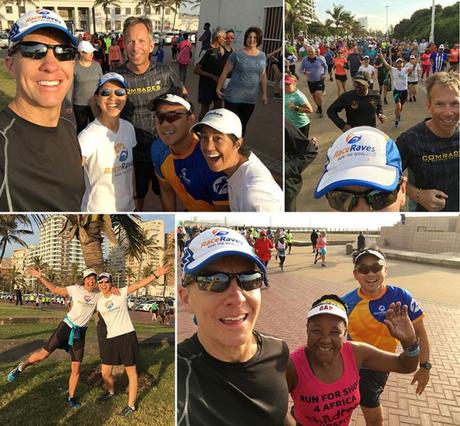
Durban North Beach parkrun (clockwise from top left): Shaking out our selfie muscles with John from Anchorage, center; Cath turns parkrun into a full-body workout; catching up with Marathon Granny Joyce from Kenya; Cath and Katie do their best human butterfly impression
The rest of our Saturday had been overly restful, so that after a solid five hours of sleep I’d awoken on Sunday morning feeling well rested and ready to go, with the voice of experience in my head calming any potentially skittish butterflies in my stomach. After all, as noted American poet Peyton Manning once said, “Pressure is something you feel when you don’t know what the hell you’re doing.” With one Comrades finish under my belt, I liked to think I knew what the hell I was doing.
After a semi-normal breakfast (as normal as 2:00am breakfast can be), Jimmy, Beth and I hopped aboard the 2:45am shuttle bus for the long and (luckily) uneventful ride to the start of our personal journey in Pietermaritzburg.

Asijiki: No Turning Back (Pietermaritzburg to Little Pollys)
Now, with confetti falling all around us, Jimmy and I crossed the start line two minutes and 30 seconds after the gun, 30 seconds slower than last year. As the sea of official red-and-white race caps disappeared into the darkness ahead of us, I fell into a comfortable jog alongside Jimmy, gauging the weight distribution of the lightweight Ultimate Direction pack on my back that held my limited assortment of baby food pouches and GU packets. Learning my lesson from last year’s race, I’d left the hydration bladder at home.
[Comrades Tip #2: Resist the urge to carry a hydration bladder — there’s plenty of water, Energade etc. along the course. If you must carry a pack, limit its contents to solid nutrition.]
Our game plan was simple: start strong to give ourselves a realistic shot at a 9-hour finish (Bill Rowan medal) and then adapt on the fly. Though I knew Jimmy’s competitive streak would drive him to push for 9 hours, I also knew I hadn’t trained to run a sub-9 finish time myself. After a high-mileage training program that enabled my come-from-behind run for charity at January’s Houston Marathon, I’d barely squeezed in a Corral C qualifying time at my hometown Los Angeles Marathon in March, registering at the last minute before beating the cutoff by a whopping 11 seconds. So I didn’t exactly arrive in Durban Bill Rowan-ready.
Even if I had trained properly, pausing along the route to take pictures would easily add 10-15 minutes to my finish time. If everything went according to plan, I saw 9:30 as a more likely scenario, with my primary goal being sub-10 hours as in 2017.
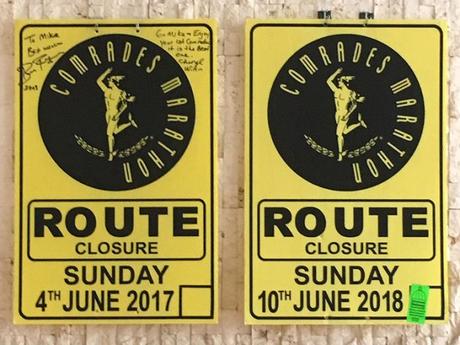
Not only had I not trained for a sub-9, but downhill running isn’t my strength — I’m much more consistent on the uphills. Whereas many runners naturally post faster times on the down run (with its 6,000+ feet of elevation loss vs. 4,000+ feet of elevation gain), I’d diligently trained my quads to survive and hopefully thrive on the extended descents between Pietermaritzburg and Durban. To my usual training regimen I’d added twice-a-week lunges and eccentric quad strengthening, the latter on the recommendation of Rory who’s completed the down run six times. I’d even run the REVEL Mt Charleston Marathon in late April, a doozy of a test run boasting a net elevation loss of 5,300 feet over 26.2 miles.
So my quads were as ready as they’d ever be to tackle the challenge of the Comrades down run.
Luckily we’d have the ultimate wild card on our side this year — the South African winter. Unlike the previous year’s unseasonal heat and unrelenting sunshine, this year’s temperatures were expected to peak in the mid-70s with regular cloud cover to keep the sun at bay. Given that my spring training regimen had included spending 20-30 minutes a day six days a week in a 180°F sauna to build my heat tolerance, this was welcome news. And it would help to make up for the fact that the 2018 course would be the longest in 23 years.
At 90.184 km, this year’s down run would be the longest Comrades course since 1995 and nearly 3½ km longer than last year’s up run, which measured 86.73. Assuming I matched last year’s average pace of 10:53/mile, the extra distance would add over 23 minutes to my projected finish time. So never mind sub-9 hours — I’d have my work cut out for me if I hoped to improve on last year’s finish time of 9:52:55.
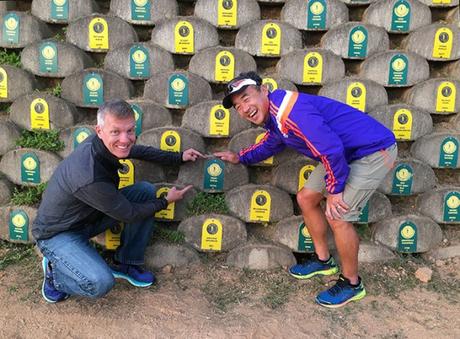
Paying homage to Rory’s Green Number plaque on the Comrades Wall of Honour
Like a gracious host reminding us that this was indeed the down run, the narrow road leading out of Pietermaritzburg started on a gentle descent. As my nerves fired and my pulse rate quickened, I did a full-system check to ensure all systems were go. My gut had dodged a bullet thirty minutes earlier after each and every porta-potty outside the start corrals had inexplicably run out of toilet paper, with no one to refill them. Talk about a helpless feeling, and only a bit of last-minute ingenuity had saved the day…
[Comrades Tip #3: That gauzy Bonitas hospital gown included in your pre-race goodie bag for warmth on race morning? It can also be torn into convenient strips for use as toilet paper.]
Jimmy and I cruised through the darkness of Pietermaritzburg and into Ashburton, the early route narrower and more tightly packed than it had been on last year’s up run, when we’d exited Durban via the well-lit N3 highway. In the pitch black I fell into a rhythm, quieted my mind and focused my mental energy on avoiding potholes as well as other runners carelessly drifting across invisible lanes of traffic.
On that note, I found myself frustrated by the sheer number of runners who seemed either unable or unwilling to run a straight line. And I know I wasted a nontrivial amount of energy pumping the brakes as restless runners insisted on weaving in front of me.
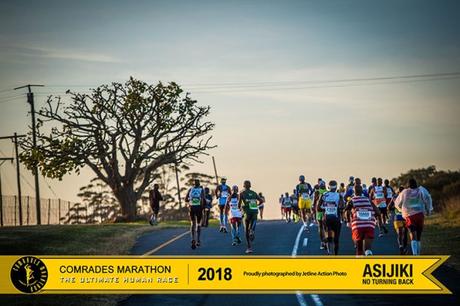
Though Jimmy and I would run together in the early going, each of us had every intention of running our own race. Because despite the fact that you’re surrounded by thousands of other runners and countless screaming spectators throughout the day, Comrades — more so than any other race I’ve run — is a very personal affair. It’s called the Ultimate Human Race for a reason: Comrades is 90 km of you vs. you, and for most of us that’s plenty of competition.
After wearing RaceRaves gear in my Comrades debut, I’d decided to go the patriotic route this year with USA flag shorts, Statue of Liberty calf compression sleeves, an American flag behind my bib number on front and back, plus stars & stripes sunglasses I’d bought for $1 at Target to round out my wardrobe. Bruce Fordyce had recommended wearing our national colors the year before — “I can’t understand why someone travels all this way to run Comrades, and then runs in a San Diego Marathon shirt” — and I’d witnessed first-hand the raucous reception other runners had received for proudly sporting their national colors.
As I’d soon discover the red, white and blue elicits a curious mix of reactions, and especially among 80 nations in which Americans account for less than 1% of the field. Sadly I missed this exchange, but according to Jimmy a women behind us in the early miles saw my shorts and yelled, “Go America!” to which a salty Brit behind us responded with, “Said no one evah!” In response to Jimmy’s sideways glance he added sheepishly, “Sorry, don’t hate me.”
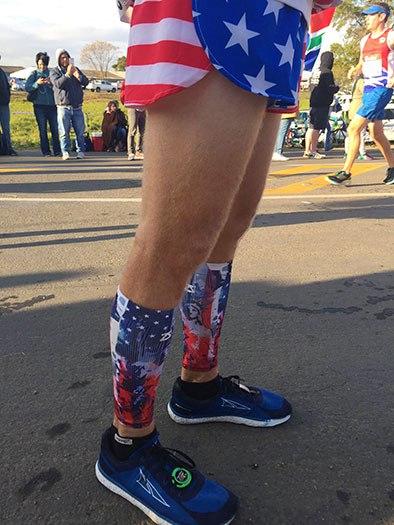
Comrades is the perfect opportunity to showcase your patriotism
Daybreak’s pale, pink-tinged lips kissed the sky as we reached Polly Shortts — the last of the “Big Five” hills on the up run — at the 82 km mark. As the pace accelerated on the mile-long descent, I paused for important business by the side of the road while Jimmy shot ahead. Though he quickly vanished out of sight, I reeled him in on the next short climb before the pace again increased down Little Polly’s.
It was on Polly Shortts and her sister Little Polly’s (Little Mpusheni) that I realized Jimmy and I were running different races. While he attacked the downhills with gravity as his muse, I worked to keep my pace in check without riding the brakes. Because starting too fast is the #1 cardinal sin of Comrades, and I hadn’t come all this way just to shred my quads before sunrise.
77 km to go.
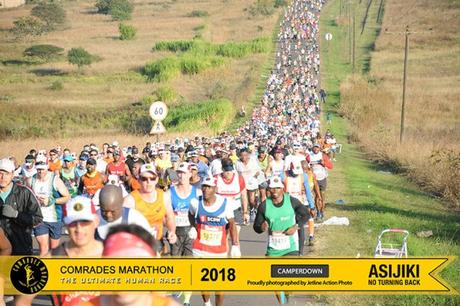
Little Pollys to Harrison Flats
After Little Pollys, we switched gears once again for our longest extended climb of the day up to Umlaas Road. Along the way we passed under the N3 to reach the first of six cutoff points at Lion Park (~75 km to go). Unsure of the best way to mentally divvy up 90 km, I’d decided the six time cutoff stations would be my best landmarks, as they stand 10-15 km apart.
Despite its significance as the highest point on the course (2,700 feet), Umlaas is nondescript and easily missed during the race — and especially on the down run, where it arrives so early. Except that this year, rounding a corner I happened to glance Rory’s tall distinctive frame among the spectators lining the road.
Unfortunately by the time my brain processed the moment I’d passed Rory by, and so not wanting to slam on the brakes and risk causing an accident, I turned quickly, yelled his name and threw up my hand in greeting as I continued on my way. I saw him respond to his name, but whether he’d recognized my voice or seen me in the crowd, I had no idea.

Savoring sunrise on the way to Camperdown
One advantage of the down run is the opportunity to cover the relatively quiet, wide-open stretch through Camperdown and Cato Ridge early in the day, before the sun is high in the sky. I could still recall how interminable these long, desolate and unshaded miles had felt during last year’s up run, with Inchanga in our rear-view mirror and Polly Shortts yet to come.
A pungent odor hit my nostrils, more like rotting animal carcass than the familiar Camperdown chicken farm smell I remembered from the year before. Luckily it passed as quickly as it had appeared. No harm, no fowl.
I texted Katie to let her know we were 2 km away from where she, Cath and Miguel would be waiting. I’d missed her and Rory at our first meeting place last year, and I didn’t want to make the same mistake again. We’d also made the sage decision this year to invest in a South Africa SIM card for our iPhones upon landing the Johannesburg airport, so we’d be able to text freely throughout the trip.
We reached our terrific trio at the 66 km mark with Jimmy about a minute ahead. He passed the trio quickly without stopping while I paused for a couple bites of a peanut butter & jelly sandwich to supplement the baby food pouch I’d downed earlier. And I laughed as Cath, responding I think to Jimmy’s own sense of focus, urged me to get going while I took a minute to stretch my legs and pose for a picture with Katie.
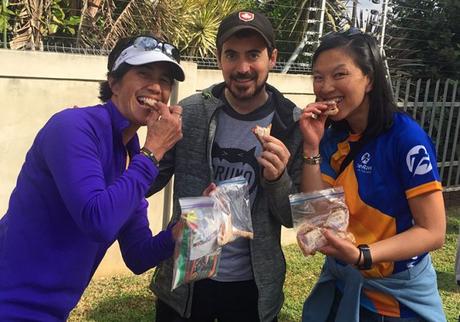
Even the best seconding crew in South Africa’s gotta eat!
Seconding is a key part of the Comrades experience for both runners and crew; I appreciated their being there, and the excitement on their faces was a definite pick-me-up. I also knew that one or two minutes per pit stop wouldn’t make an appreciable difference in my final time. My nonchalance was fueled by my desire to enjoy race day to the utmost, but also by what I consider to be the most glaring oversight on the part of the Comrades Marathon Association. Let me explain…
One of the distinguishing characteristics of Comrades is its distinctive finisher medals, awarded on the basis of finish time as follows:
- Gold: Top 10
- Wally Hayward (named for the 5-time Comrades Marathon champion and oldest runner to finish the race): Out of the top 10 but less than 6 hours
- Silver: Greater than 6 hours but less than 7½ hours
- Bill Rowan (named for the first Comrades Marathon winner in 1921): Greater than 7½ hours but less than 9 hours
- Bronze: Greater than 9 hours but less than 11 hours
- Vic Clapham (named for the Comrades Marathon founder): Greater than 11 hours but less than 12 hours:
What jumps out at me from these numbers is the sizable two-hour gap between the first and last Bronze medalists. In this year’s race, bronze medalists accounted for 39% of finishers, compared to 31% for Vic Clapham and 13% for Bill Rowan. To my mind, the difference in performance between a runner who finishes Comrades in 9:01 and one who crosses the finish line in 10:59 is significant enough to merit distinct medals.
So then why not introduce a new medal, say the Bruce Fordyce medal, for runners who finish between 9 and 10 hours? Named after the race’s 9-time champion and its premier ambassador, the promise of a Bruce Fordyce medal would immediately inspire many runners who are on the cusp of 10 hours to train harder and run a smarter, more focused race. At the same time, it would set an exciting new standard for sub-10 runners like me — who currently know a Bronze medal awaits us whether we finish in 9:45 or 10:15 — and encourage us to treat the race with less nonchalance, knowing a sub-10 finish means the difference between a Bruce Fordyce medal and a Bronze.
So how ‘bout it, CMA?
The aid stations were as efficient and energetic as I remembered, though thanks to the cooler temperatures I didn’t need to visit quite as many this year. But despite the availability of trash bins, the streets around each aid station were littered with discarded water and Energade sachets, some still partially filled so that they emitted a last-gasp {POP} when stepped on.
[Comrades Tip #4: Unless you’re in the lead pack, toss your used cups and sachets off to one side of the road, near a trash bin. If you don’t like tramping over discarded trash and half-filled water balloons, why should the runners behind you?]
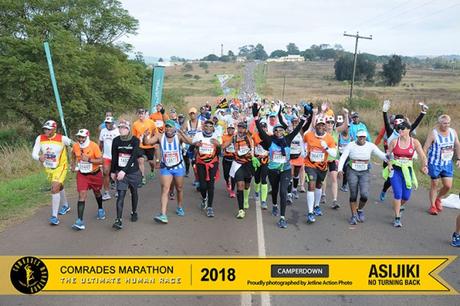
The 12-hour “bus” (pacing group) rolls through Camperdown
During the course of running 90 km you’re bound to experience at least one aid station snafu, and my most memorable came courtesy of a harmless-looking orange slice which I gratefully accepted from a proferred plate. Biting down to release the sweet juice, I was instead greeted by an unwelcome saltiness that nearly caused me to gag. Instinctively I spit out the foul fruit, my taste buds scrambling to reconcile the sensation of salty where there should only have been sweet.
Unfortunately by this time I’d already passed the aid station, and so it would be another km before I could wash the salty aftertaste {blech} from my mouth. Later in the race I’d grab another orange, but not without first interrogating the poor volunteer as to the flavor profile of his fruit. To his credit my ramblings didn’t faze him, and I thanked him as I jammed the sugary slice in my mouth.
Given my newfound suspicion of something as familiar as oranges, you can bet that I politely declined the offer of mageu, a milky drink made from fermented mealie pap and offered at aid stations in plastic yellow bags.
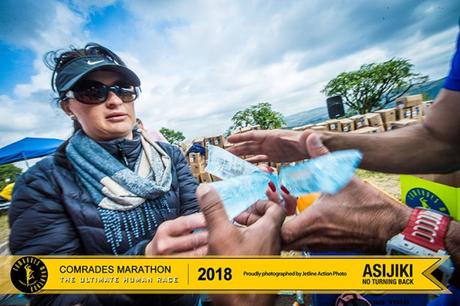
An aid station volunteer offers water sachets to thirsty runners
My stars & stripes running kit was a great conversation starter, with both international runners and fellow Americans curious to know where in the U.S. I was from and eager to share their own home country or state. And my kit complemented the race’s own strategy to distinguish South African and international runners — its colorful bib numbers.
True to the camaraderie of the event, the Comrades bib numbers communicate a wealth of information at a glance. I enjoyed congratulating other back-to-back runners, first-time international runners (as indicated by the “0” under “Medals” on their blue bib numbers) and especially Green Number hopefuls, whose yellow bib numbers distinguish them as 9-time finishers in pursuit of that coveted 10th finish. For the recreational runner, few achievements rival that of earning a Comrades Green Number, and the Green Number Club currently boasts 13,000+ members from the race’s 93 years.
Passing the second cutoff point at Cato Ridge (~60 km to go) brought us to the ironically named Harrison Flats. Luckily its rolling roads struck me as less challenging from this direction with their net downhill profile, and so I was able to make up time as the Old Main Road led us down into the belly of the waiting beast, my old buddy Inchanga.
56 km to go.
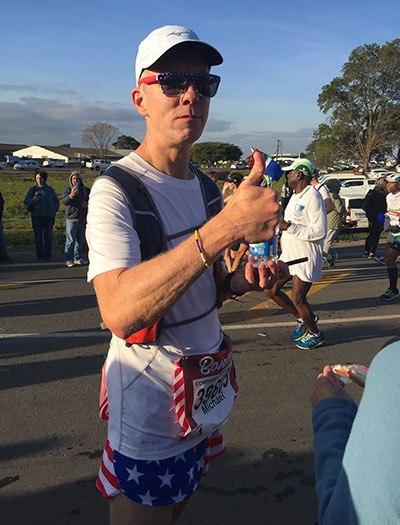
Harrison Flats to Drummond (Inchanga)
Though my energy levels remained high, all the climbing and descending was starting to wear on my legs as we made our way up the backside of Inchanga. And speaking of backsides, I can now appreciate that even though the Big Five — Polly Shortts, Inchanga, Botha’s Hill, Fields Hill and Cowies Hill — are notorious landmarks on the up run, they’re just as much a pain in the ass on the down run. Because it’s not like they suddenly flatten out in the opposite direction.
Climbing up the back of Inchanga we reached my favorite section of the course, the Ethembeni School for physically disabled and visually impaired children. At the same time emotionally disturbing and hugely uplifting, no memory of Comrades race day stands out like seeing the troubled children of Ethembeni, many with unfocused or faraway looks in their eyes, lined up with hands outstretched in the hopes of securing a high-five from passing runners.
Still wearing the beaded bracelet I’d received last year from the school’s headmaster, I smiled and high-fived every tiny hand available to me, in the hopes that feeling my encouraging slap on their palm might lift their spirits and, for even a brief moment, bring a smile to their face or heart.

Turning down the backside of Inchanga
Our brief visit to the Ethembeni School, coupled with the view from the top of Inchanga as runners below us descended the beast like two-legged ants, was well worth the struggle. Particularly since that struggle hadn’t been waged under direct midday sunlight.
Then down, down gravity carried us once again as I lay off the brakes and opened the throttle, taking the opportunity to catch my breath before the course briefly leveled out at its ceremonial midway point (cutoff mat #3) in Drummond. There the folks from Hollywoodbets greeted us alongside their familiar purple-and-yellow inflatable arch with music blasting and spectators screaming, as though we were celebrities, rock stars and supermodels. And while “loud” typically isn’t my scene, I tried to appreciate the raw energy of the moment before we’d immediately shift gears and start climbing again.
Because in case you hadn’t noticed, much like labeling Earth as “blue,” the terms “up run” and “down run” can be pretty misleading.
46 km to go.
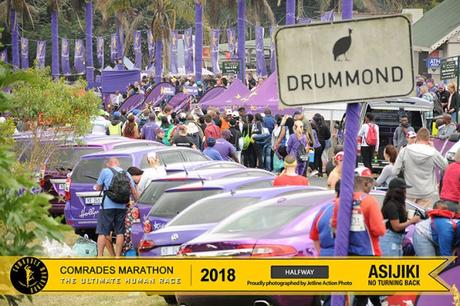
Drummond to Winston Park (Botha’s Hill)
Unlike the up run where the second half begins with the nasty climb up Inchanga, this year we had something to look forward to on the climb out of Drummond and the Valley of 1,000 Hills.
First I paid a brief visit (along with a steady stream of fellow runners) to Arthur’s Seat, a shallow alcove carved out of the rock embankment on the south side of the road where 5-time Comrades champ Arthur Newton reportedly used to rest during his training runs. Legend has it that those who greet Arthur and leave him flowers during the race will enjoy a strong second half. And though my greeting had apparently fallen on deaf ears the year before, there was no use tempting fate by being an ugly American.
“Good morning, Arthur,” I said, leaning in and tapping the rock face gently as if to awaken its sleeping denizen. Who am I to flaunt tradition?
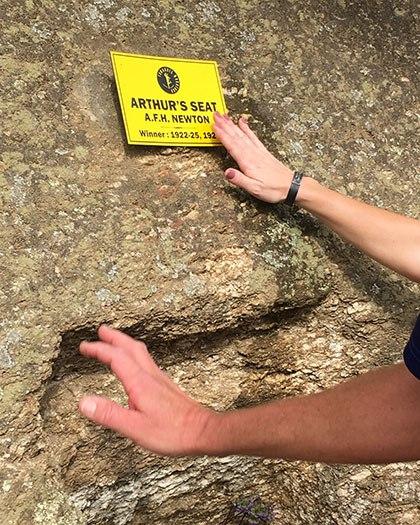
Just beyond Arthur’s Seat on the north side of the road stands the Comrades Wall of Honour, with its collection of plaques set in individual stones and labeled with the names and bib numbers of previous Comrades finishers — yellow plaques signify those with fewer than 10 finishes, whereas green plaques recognize members of the Green Number Club with 10 or more finishes. Amazingly, anyone with an official Comrades finish can buy their own plaque to be displayed on the Wall. Can you imagine the folks at the Boston Athletic Association doing something similar for Boston Marathon finishers? Talk about great fundraising for the B.A.A.
Rounding the corner from the Wall of Honour I spied Katie, Cath and Miguel waving to get my attention. Pulling alongside them, I was psyched to see that Rory and his brother Kirby had joined them. Rory apparently had recognized me at Umlaas and had texted Katie to coordinate their positions. They all looked to be thoroughly enjoying themselves. Katie informed me that Jimmy was about five minutes ahead and that they’d been able to see Beth in Camperdown. Good news all around.
Seeing the five of them was a solid pick-me-up, as was the Tailwind mix I sipped while catching my breath and stretching my legs. I could feel my quads growing heavy from all the hill work, and worried that they’d only continue to tighten as the miles mounted. Luckily the course would be largely downhill from here (= “down” run). So I did what I could to quickly loosen my weary legs before pulling back into traffic and continuing on toward Durban.

Miguel and Beth celebrate her farthest run ever in Drummond — only a marathon+ to go!
Looking around at the caravan of runners, I reflected on the fact that as a woman Beth was definitely in the minority here. Female runners made up less than ¼ (23%) of Comrades registrants and only 31% of international runners this year, consistent with the disproportionately lower number of female participants in ultramarathons around the world. This despite the fact that in the United States, women runners now outnumber their male counterparts. Attracting female runners should clearly be a priority for the Comrades Marathon and ultrarunning in general.
On the up run, Botha’s Hill is the third of the Big Five. On the down run, as Lindsey Parry had noted in his pre-race briefing, Botha’s is in fact three separate hills. And while none of the three is particularly steep, the road just seemed to roll ever upwards toward the sky, a physically and psychologically exhausting reality that turns many runners into walkers.
At last we crested Botha’s Hill and reached Kearsney College, where the students had apparently returned home early from a rugby tournament so as not to miss Comrades Day. Some boys lined the road while others sat in bleachers off to one side, each sporting his distinctive blue blazer with its “CARPE DIEM” crest on the lapel.
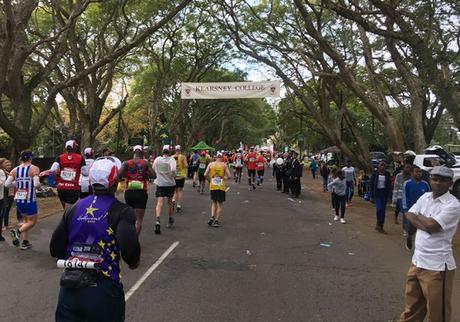
Welcome to Kearsney College and the top of Botha’s Hill
Lindsey Parry’s advice on the down run is to run conservatively until you reach the top of Botha’s Hill, just past the 50-km mark. Then, if you’ve played it smart and still have your legs under you, you’ll be able to pick up the pace in the final 40 km. Luckily my legs felt no heavier than they had during my pit stop in Drummond.
On the other hand, my body was once again rejecting the notion of solid (or even gelatinous) food, and so I knew the next 40 km would be challenging from a nutritional standpoint.
Reaching the bottom of Botha’s Hill, a nasty 1 km uphill jag welcomed us to the town of Hillcrest, one of the most raucous sections of the course. There, supercharged spectators lined the road, whooping and cheering their support for the runners. Many of them focused specifically on my stars & stripes with cries of “Go USA!” and “U-S-A! U-S-A!” I pumped my fist lightly in appreciation, not wanting to sacrifice too much adrenaline to the cause of patriotism.
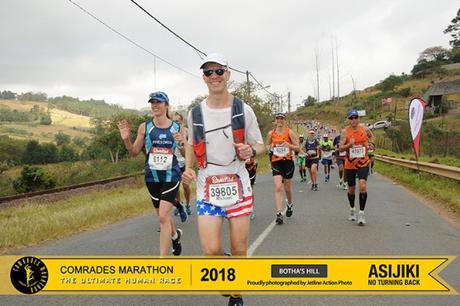
If you were to close your eyes (though hopefully not while running) and judge solely by the music along the course, you could be forgiven for thinking Comrades was a US race. I heard plenty of American favorites including the theme song from Rocky and (twice) Journey’s “Don’t Stop Believin’ “. Unfortunately I wasn’t fast enough like Jimmy to catch “Sweet Caroline.”
Aid station volunteers were pouring salt into runners’ hands; I recoiled like a red, white and blue slug. Was it really that hot? If so, I definitely wasn’t feeling it. Though the sun was approaching its zenith, extensive cloud cover ensured its influence would be minimal.
With 32 km to go, a quick left-then-right turn on Old Main Road brought us to the fourth cutoff mat at Winston Park. Here in the vicinity of Winston Park, I heard an announcement that the second female had entered the stadium in Durban. As much as hearing this underscored the freakish disparity between our respective athletic abilities, it also heartened me to realize I was far enough along that other runners were already finishing the race.
Have I mentioned how important a positive mindset is to success at Comrades?
30 km to go.
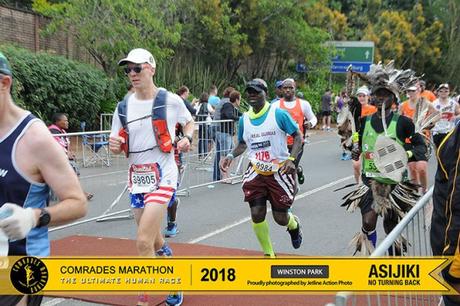
Crossing the 4th cutoff mat in Winston Park
Kloof to Pinetown (Fields Hill)
Raise the roof, I’ve made it to Kloof, I thought with a wry smile. The thought lifted my spirits, since Kloof would be my third and final meeting place with the terrific trio of Katie, Cath and Miguel.
“We’re on the right, past the Coca-Cola hoopla at ~26km to go!” Katie had texted moments earlier, and now rounding the corner on the downhill I saw the Coca-Cola aid station just past the red Bonitas sign with its countdown thermometer indicating 28 km to go. I was a bit confused until, passing the aid station, I saw the three of them waiting just beyond.
Katie estimated Jimmy’s lead at 8–10 minutes, and I was psyched to hear he was still running well. So too was Beth, who I was told had looked strong in Drummond.
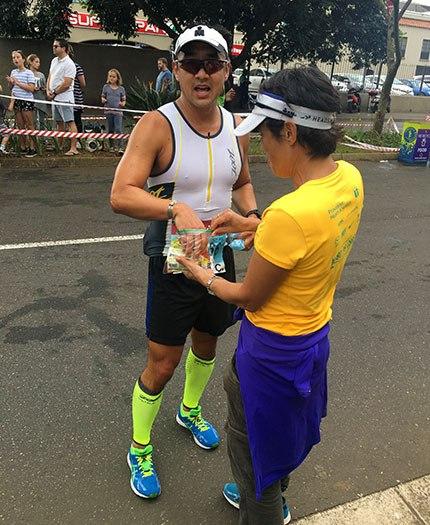
Jimmy makes one last stop to refuel in Kloof
For my part, I was thrilled to discover my legs felt no worse for wear now than they had at the midway point. Sure, the final 28 km wouldn’t be pretty, but just how un-pretty would depend more on the state of my stomach than the life in my legs. The good news was that I no longer had any need for my lightweight pack, since it wasn’t like my stomach would suddenly start accepting solid food again. So I dropped it with Katie, high-fived each of them to get my blood pumping and reluctantly bid them goodbye for the last time, promising with one last deep breath that I’d meet them at Moses.
Much like last year I know Fields Hills was long; I just couldn’t tell you how long. I do know it ended in Pinetown, an ending that couldn’t come soon enough. Because while the fourth member of the Big Five is definitely long and steep, it’s neither of these endearing qualities that makes Fields Hill public enemy #1 on the down run. That distinction belongs to its awful camber, which punishes the legs like nothing else on the Comrades course. I could easily see how runners might succumb to the siren song of Fields and fly down its steep slope, only to blow out their quads before Pinetown. And while Pinetown features plenty of car dealers and auto body shops, I didn’t notice any businesses touting “quad and calf repair while u wait.”
So I was relieved to reach the fifth cutoff point in Pinetown with my quads intact, and I’m confident my strength training (plus the REVEL Mt Charleston Marathon as a downhill training run) made all the difference.
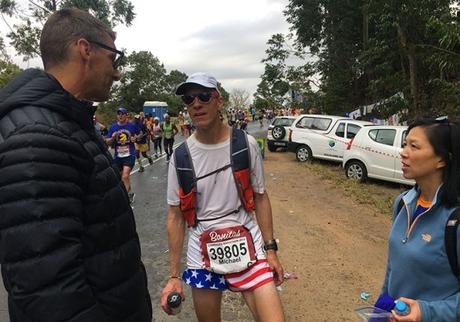
Conferring with Rory in Drummond
But though my quads remained intact, I can’t say the same for my stomach — because I still haven’t trained it to eat at the speed of Comrades. Thanks to the cooler weather I was able to snack more this year than last year, nibbling on a banana here and an (unsalted) orange there, along with two of my baby food pouches (200 calories, par-TAY!). Eventually, though, as has become its modus operandi, my stomach rebelled at any hint of solid food, so instead I resorted to the occasional sip of Coke or Energade to satisfy my body’s caloric cravings.
Turns out the problem with this strategy was the disconnect between mind and body — whereas my mind told me I needed the sugar/calories, as soon as I’d take another sip of Coke or Energade I’d feel the uncomfortable sloshing in my stomach. I ran ~15K from Kloof to Pinetown to Westville feeling like a human water balloon, even stopping once to answer nature’s call at a Pinetown porta-potty.
Finally, in the midst of my rising frustration it occurred to me to just ignore my mind and let my body use its fat stores as fuel, as I had for so many of my training runs. And though this certainly didn’t have the same magical effect as Popeye’s spinach, at least I was able to ease the bloating and get back to running (semi-) comfortably the rest of the way.
Again, it’s called the Ultimate Human Race for a reason: you have to be ready, willing and able to adapt, mentally and physically, to any challenge and any situation.

Pinetown was off the chain, much more so (understandably) than during last year’s up run when we’d arrived early in the day at around the half marathon mark. Now, loud and high-spirited crowds several deep lined the road, which narrowed at one point to almost single file as spectators pressed in from both directions. Boisterous chants of “U-S-A! U-S-A!” filled my ears, and I seemed to be running with my hand in a perpetual “thumbs-up” position.
Pinetown was amazing.
One of the human highlights of Comrades is the volunteers — like the race itself, they’re in a class by themselves. They do a remarkable job maintaining their focus as sweaty glassy-eyed runner after sweaty glassy-eyed runner shuffles toward them, eagerly snatching two water sachets at a time from their outstretched hand and often dropping one in the process. So the undisputed lowlight of the day was seeing one runner in Pinetown pause to reprimand a volunteer who apparently hadn’t lived up to his lofty expectations. “Pay attention!” the runner barked at the volunteer, who I didn’t see.
If you have enough energy to be dressing down volunteers this late in the race, I thought, you should be running harder.
Leaving Pinetown, a mild-mannered older woman saw my shorts and replied, “Oh, America… so sorry about Trump, eh?” I smiled wryly and thanked her for her sympathy, waving over my shoulder as I passed. I was admittedly curious to see what reactions my USA running kit would evoke, and hers was the overwhelming sentiment within South Africa, from runners and spectators on the course to our safari ranger several days later who matter-of-factly referred to our 45th President as “a retard, eh?”
20 km to go.
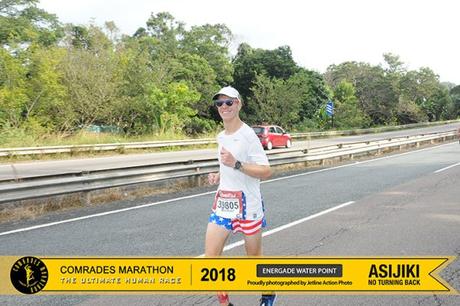
Based on the crowds around me, I must have been leading the race at this point
Pinetown to Mayville (Cowies Hill)
With nearly 72 km (45 miles) in my legs, the last of the Big Five loomed large. On the up run, Cowies Hill makes an early appearance as a key part of the long, steady climb toward Drummond. On the down run, though, it includes a nasty ½ mile ascent that reduced me unashamedly to a walk and earned me with a 12:25 mile, my slowest moving mile of the day. Luckily the payoff for reaching the top of Cowies was a smooth downhill run into Westville.
[Comrades Tip #5: Uphill, downhill, it doesn’t matter — smile for the photographers when you see them. One moment of faux happiness is worth a lifetime of memories. And at very reasonable prices relative to other large races (I paid ~$33 USD for the entire digital package), you’ll likely want to purchase your race day photos.]
Descending toward Westville I thought Ah, so this is why it’s called the down run. Seeing the urban landscape of Durban laid out below me, I let myself relax as waves of suppressed fatigue washed over me. Having been on my feet for over eight hours, I let my mind wander as as we cruised along King Cetshwayo Hwy, the encouraging shouts of the spectators now sounding muffled and distant as I retreated into my own head.
Last year the 10-hour “bus” (Comrades-speak for a pacing group) had caught me as we approached Little Polly’s with 10 km to go. I was determined that wouldn’t happen this time as I kept pushing forward whenever possible. At the same time, I still recalled the punishing latter stages of last year’s up run and had no desire to relive that misery. Because the thought suddenly struck me like a bolt of lightning on a clear day — this may be the last time I ever run Comrades.
With that sobering thought in mind, I allowed myself to look up, look around and use my walk breaks to soak it all in. I basked appreciatively in the adulation of the endless throngs with their tireless cheers, their uplifting chants of “U-S-A! U-S-A!” and their altruistic offers of whatever we needed to help us get to Durban.
Yes, I wanted to run my best possible Comrades — but not at the expense of hating the final 20 km.
My reverie was shattered by a fellow runner dressed in African tribal gear who insisted on blowing his referee’s whistle as loudly and as frequently as possible. And while I appreciated both his enthusiasm and his outfit (and especially his ability to run 90 km in such an impressive headdress), at that moment I wanted to be anywhere else but running next to him and his freaking whistle. So whenever he’d pull alongside me with several shrill blasts to announce his whereabouts, I’d quickly speed up just enough to propel myself out of his direct earshot.
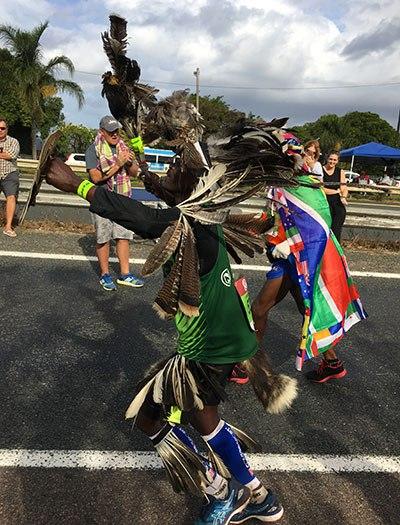
I’m sure the spectators appreciated his shrill whistle
In my bid to conserve energy, I wasn’t happy at being forced to accelerate in short, sporadic bursts. It felt like a bad dream where I’m trapped in drill team practice and can’t escape. And I wondered irately, Why blast a f@*#king whistle in your fellow runners’ ears for 10 hours?
Luckily I soon pulled far enough ahead to escape his one-note recital. The silver lining? His shrill blasts helped me stay sharp and maintain focus as we descended into Westville. After all, this stretch along King Cetshwayo Hwy is a quieter section of the course where, with Cowies behind and Durban ahead, it’s easy to lose your mental edge momentarily and feel fatigue setting in.
In the final ten miles or so as we neared Durban, every uphill seemed to require at least a short stint of walking, usually just long enough to take a few deep breaths and pull myself together. And though my legs were always reluctant to start running again after these slowdowns, once I did I found myself able not only to run but to run well, making solid progress and passing other runners. So I was definitely using the walk breaks to my advantage.
In Mayville we crossed the sixth and final cutoff mat, the last major milestone en route to finish line glory.
9 km to go.
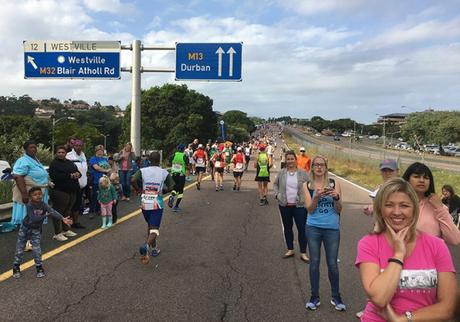
The crowds thinned a bit between Cowies Hill and Westville — it is a highway, after all
Mayville to Moses Mabhida Stadium (finish)
One of the most memorable climbs of a long and memorable down run was also one of its shortest — the on-ramp from the M13 to the N3 at around the 83 km mark. After a sharp left turn, this steep uphill jag greeted us with a rise of 50 ft in just over 1/10 mile.
As I power-hiked upward to begin my final approach to Durban, a South African runner congratulated me on having my back-to-back medal “in the bag” — which at that moment sounded brilliant. I thanked him, and seeing my shorts his friend added that “Trump would be proud of you.” “Don’t think you want to go there,” the first fellow responded, and I agreed with a nod that our President’s approval was the furthest thing from my mind. Didn’t these two realize that exercise only depletes the body’s finite amount of energy?
[Comrades Tip #6: For all things coaching, Lindsey Parry is the definitive voice of the Comrades Marathon. That said, I’d respectfully disagree with his claim that the N3 on-ramp in Mayville is the last real uphill on the down run. With 84+ km in my heart and legs, the subsequent climb up to Tollgate and the N3 off-ramp into Durban both took the wind out of my sails.]
While it’s easy to predict the beating your legs will suffer over the course of 90 km, what may be less obvious is the steady pounding absorbed by the core muscles of your stomach and lower back. As we crested Tollgate my core muscles grew increasingly weary, and I did some quick high knee lifts in the hopes of granting them a momentary reprieve.
As it turns out, it’s tough to do much of anything without full cooperation from your back and stomach.
On the other side of the highway, drivers heading in the opposite direction honked (or hooted, as the South Africans say), and passengers hollered their support from passing cars. Which reiterated the insane fact that on this day we silly, selfish runners pursuing our silly, selfish hobby were the proud focus of a nation 56 million strong. And that humbling reminder immediately put a pep in my step.
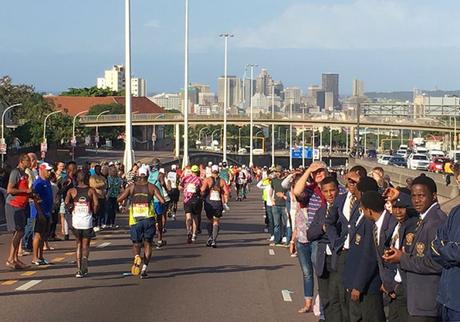
Hello Durban!
With around 7 km to go the concrete, steel and glass skyline of urban Durban came into view at last. The moment was empowering, to be running on a national highway lined with cheering supporters as the sprawling skyline of South Africa’s third largest city — and our final destination — beckoned in the distance. Welcome, the soaring gray skyscrapers seemed to say. We’ve been expecting you.
Pulling out my iPhone for a picture, I happened to glance down at the time: 2:35pm. Which meant I had roughly 54 minutes to cover 7 km and still finish in less than ten hours, a much slower pace than I’d been running to that point. And I’ll be honest — after seeing the time and doing the math, it became increasingly difficult to push myself any harder. As long as I broke ten hours, what was the difference between finishing in 9:54 (last year’s finish time) vs. 9:44? Aside from my overall place in the final results, to my mind there was no meaningful difference.
Moments like this emphasize the importance of a well-defined goal to help maintain focus; without one, a race like Comrades becomes even more challenging than its 90 km distance.
Though barely a blip on my final Garmin tracing, the last uphill of the day would be the N3 offramp that would drop us down onto the city streets of Durban for the final 5 km. Though not a formidable climb at any other time, glancing up now I felt almost dizzy following the sweeping arc of the overpass as it curved upward and away toward Moses Mabhida Stadium. And so, with heavy legs and a light head, I walked.
From there the course did something it hadn’t done in the first 85 km — it leveled out.
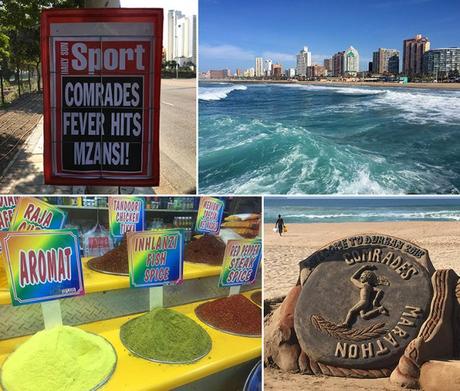
Scenes from Durban (clockwise from top left): “Mzansi” is the Xhosa word for South Africa; Indian Ocean’s-eye view of the beachfront; with an expected R355 million (~$24 million USD) impact on Durban’s economy, Comrades is all around you; street market spices — the city is home to the world’s largest Indian population outside India
We’d been told so many times leading up to race day that the new course would pass by the old finish venue at Kingsmead Stadium, that by the time we finally passed the unassuming cricket facility with 3 km to go, I felt as though I’d been here before. But even with 87 km in my legs, I was more than happy to bypass Kingsmead in favor of shiny new Moses Mabhida Stadium, which as we rounded the bend just past Kingsmead came into full and glorious view.
From there, the final “Toyota Mile” was a straight shot past the cheering masses lining Masabalala Yengwa Ave, as though Moses (Mabhida) himself were parting the sea of spectators ahead of us.
“Hello, Moses.”
“I see you, Moses.”
“I am coming, Moses.”
I glanced over at the gaunt fellow mouthing these words to my right and smiled weakly as the object of his desire rose up to greet us. The screaming onlookers faded into the background as I focused on the stadium’s distinctive ladder-like arch, reminiscent of a DNA double helix. Meanwhile, the asphalt beneath my feet rolled by like an urban treadmill. One step at a time. Step, stride, repeat. Feel free to breathe.
Absurd as it may sound, even better for me than seeing the finish line at Comrades is seeing the big red Bonitas sign announcing 1 km to go. Because that’s when I know the official victory lap begins. Being nearly 11,000 miles from home, soaking in that last ½ mile while basking simultaneously in the exhaustion and glory of the moment is like no other feeling I’ve experienced as a runner. And that includes right on Hereford, left on Boylston.
The understatement of the year — on Africa or any other continent — goes to the official-looking banner hung the full width of a pedestrian bridge just outside the stadium that read earnestly, “THERE IS NO TURNING BACK NOW!”

Nothing like a bit of last-minute motivation at 89 km
Then we’d arrived, and with a left turn we entered the stadium through a dark tunnel, emerging onto the bright green grass of the playing field. Ironically, after running under open sky for nearly ten hours, I suddenly felt very small under the venue’s massive open-air roof surrounded by 56,000 seats. Originally built to host the World Cup in 2010, Moses Mabhida Stadium is a breathtaking venue in which to complete your Comrades journey.
I’ve heard other runners, in the full throes of cliché, say there are no words to describe the finish of the Comrades Marathon. I disagree. There are plenty of words, with “freaking awesome” being the first that come to mind. The last stretch from entrance tunnel to finish line is a moment of sheer exultation that I wish I could have bottled to relive and share with others for the rest of my life. And when I die, the bottle could live on, inspiring other runners in its new home at the Comrades Museum in Pietermaritzburg.
The familiar green-and-white finish line topped with its double balloon arch welcomed us in full view — unlike last year’s winding finish inside the Scottsville Racecourse, there would be no game of “Find the finish line.” I savored those final 100m to the fullest, scanning the stands quickly for familiar faces before raising my arms in triumph and completing my back-to-back quest in an official time of 9:48:25.
U-S-A! U-S-A! U-S-A! U-S-A!
0 km to go. AND… breathe.
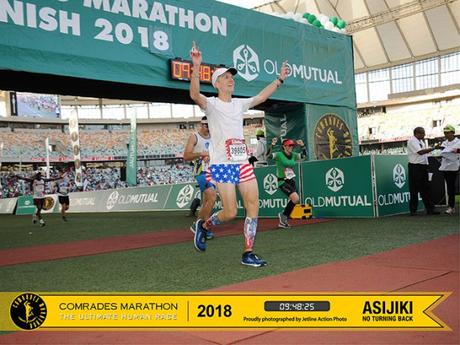
Holy Moses!
Wobbling to a stop after my longest run ever, the first booming voice I recognized was Rory’s, and I glanced up into the stands to see him clapping excitedly in my direction. I was psyched to see him, and I can’t tell you how much it means to receive personal congrats from a fellow who finished this race 12 times, who earned a Green Number and to whom this event means so much.
Shuffling through the finish chute, I gratefully accepted my second consecutive bronze medal and Comrades patch, though sadly a yellow rose was excluded from this year’s awards. Hopefully Katie would understand when I showed up empty-handed.
Looking up at the steps that led from the field to the International Runners seating area, the grim reality of Moses Mabhida Stadium reared its ugly head. Because after covering 90 km in less than 12 hours, there’s nothing a runner wants less than to climb or (worse) descend stairs, and especially a stadium full of them. On the bright side, thanks to the mild weather I was in better post-race shape than last year when I’d been unable to move, much less negotiate stairs.
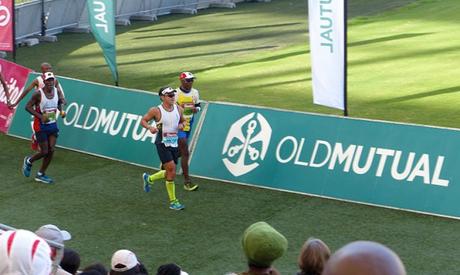
Jimmy’s day-glo calves put the finishing touches on their first ultramarathon
One slow and unsteady step at a time, I ascended the concrete stairs in search of the others. I saw Jimmy seated in a section by himself and waved — he’d run a brilliant race in his first Comrades, finishing in 9:25:23. From my vantage point, he looked comfortable and none the worse for wear.
For my part, I’d run 4½ minutes faster than last year, despite this year’s course being 3½ km longer. The mild weather had a lot to do with that, as did a familiarity and comfort with the event itself. And even with all else being equal, most folks clock faster finish times on the down run.
Reaching the top of the stairs and the inner concourse, I bumped into John from Anchorage who had finished just one minute and 52 seconds ahead of me to earn a second consecutive bronze of his own. Tiredly we congratulated each other and agreed that yes, two in a row was just about enough Comrades for a while.
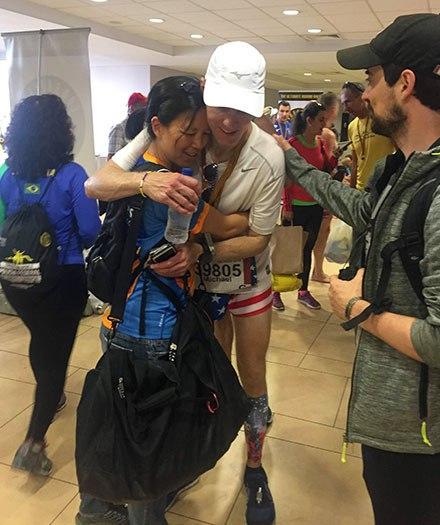
But aside from finding Katie, my immediate post-race focus was on securing my back-to-back medal. Eventually I located its caretaker, a Comrades official on the move who wore the medals around his neck and who quickly presented me with mine before hurrying past on another mission. Why the back-to-back medals hadn’t been made available at the finish line with the other finisher medals is unclear, but who am I to tell the CMA their business?
The back-to-back medal is hands-down my proudest achievement in running. If I were to come home one day to find our house in flames and I could grab only one earthly possession, my Comrades back-to-back medal may just be it. I don’t know whether I’ll have the chance to add a third Comrades medal to my collection (though I’m already eyeing Comrades #100 in 2025), but in any event the first two — along with their back-to-back brethren — will never get lonely.
At last, ambling weakly around the concourse in search of familiar faces, I found Katie and threw my arms around her, lingering for a few seconds to let her hold me up. Because the alternative wasn’t pretty.
Exhausted finishers sprawled out on the floor of the concourse as other runners and supporters gingerly stepped around them. Unlike Scottsville Racecourse which last year offered grassy expanses on which to rest and recover, Moses Mabhida provided nowhere for finishers to comfortably gather their wits. The only available options were the cramped stadium seats with little room to stretch your legs, the cold concrete ground around those seats or the floor of the concourse with its busy foot traffic.
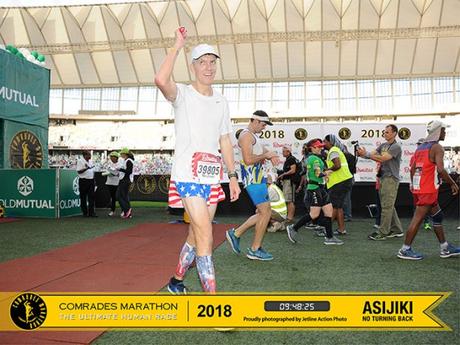
Acknowledging Rory’s support in the grandstands
None of the three options was ideal, but I needed to collapse somewhere. So while I sprawled uncomfortably on the floor of the concourse trying to a) get comfortable and b) avoid getting stepped on, Katie visited the concession stand and returned with nirvana in a cup. I don’t think I’ve had orange soda since I was like ten years old, but the Fanta orange soda she brought me at that moment was the best orange soda — and maybe the most amazing beverage — I’ve ever tasted. It was life itself, equal parts nectar, unicorn tears and liquid crack. Hello, insulin!
In addition to all the stairs and the lack of recovery spaces, massage tents (which last year were easily accessible) were inconveniently located on the outer concourse of the stadium, a fact I didn’t realize until it was time to leave. And immediately past the finish chute, South African runners were being directed to their club tents outside the stadium, meaning that unlike last year they were unable to mingle with the international runners. All because running clubs were prohibited from setting up their tents on the grass playing surface inside the stadium.
The five of us were on “Beth watch” as the clock ticked toward 11 hours. We wouldn’t be disappointed. As it turns out Beth paced the latter stages of her race beautifully, finishing with the 11-hour bus in 10:57:28 and earning her own bronze medal with 2½ minutes to spare.
With everyone present and accounted for we all reconvened, shared congratulations and then made our way toward the seats at midfield, directly in front of the finish line. Despite feeling like the walking undead, we weren’t about to miss what came next.
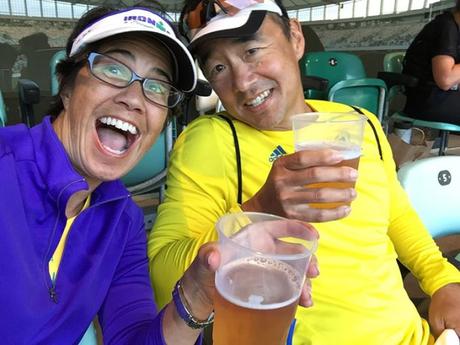
Cath and Jimmy wisely wasted no time in celebrating
The Spirit of Comrades
Without a doubt, the 12-hour cutoff for the Comrades Marathon is one of the most dramatic moments in all of sports. It’s the thrill of victory and the agony of defeat, played out within yards of each other on a national stage. And I wasn’t going to miss the opportunity to witness it in a venue like Moses Mabhida, with its warm fluorescent lighting and grandstand seating offering a full view of the finish line. Spectator viewing is where Moses Mabhida really excels as a finish venue — no offense to the rickety bleachers and overmatched floodlights of the Scottsville Racecourse.
[Comrades Tip #7: If you’re an international runner, and unless you were swept off to the med tent or have a bone protruding through your skin after the race, DO NOT MISS the 12-hour cutoff. It’s human drama like you won’t see at any other sporting event, and it may make you cling just a bit tighter to your own finisher medal.]
The announcer was again in top form for this year’s finish, setting the stage in dramatic fashion with his full-throated countdown. And it was in the final minute of the 12 hours that the Spirit of Comrades played out magically before our eyes.
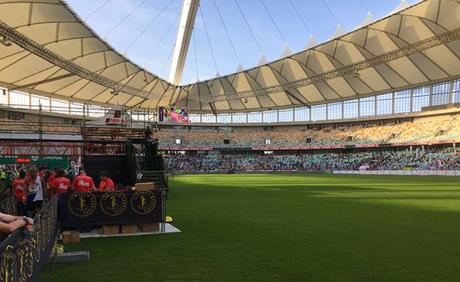
View from the finish chute inside Moses Mabhida Stadium
Wobbling down the home stretch toward the finish line like a drunken schoolboy, a runner lost control of his body and collapsed to the grass roughly 30 yards from the finish. Several fellow runners, so close to glory themselves and risking their own finish, lifted the man off the ground and supported his limp body while propelling him forward, his head bouncing listlessly like a rag doll. Only his legs still seemed to grok their role, churning slowly beneath him as the rest of his body tried to call it quits. Apparently 11 hours and 59 minutes of concentrated effort had been enough.
It was like Weekend at Bernie’s meets reality television. About five yards from the finish he collapsed for the final time, and a volunteer signaled to his impromptu crew, presumably telling them he had to cross the finish line under his own power. And so, as the energized crowd cheered him to glory, he crawled on hands and knees past the waiting human chain of volunteers and across the finish line with 40 seconds to spare. It was then that I realized I’d been holding my breath behind my camera, and immediately I exhaled and erupted in applause of my own.
I’ve never seen anything like it, and I may never see anything like it again. And if I had to summarize the Spirit of Comrades in 45 seconds, I’d probably point to this footage:
Then the final countdown began, and seconds later the human chain swung into place, blocking the finish line as approaching runners looked on in a poignant mix of horror, disbelief and resignation. So close and yet so very, very far. Like marionettes who had danced for 12 hours before having their strings cut, several dropped to the grass within yards of the finish line and lay there with exhausted bodies and broken hearts.
The six of of us stood for several heartbeats in shocked silence before our sympathy gave way to heartfelt applause. Two women seated nearby wiped tears from their eyes.
And with that, the curtain fell on the human theater of the 93rd Comrades Marathon. All the actors had played their roles admirably, and the performance would predictably garner rave reviews. The sequel opens June 9, 2019, and though the itch will undoubtedly be there when registration opens in October, I’m hoping to scratch it with a different South Africa race in 2019. But where Comrades is concerned, I’ll never say “Never again” — and especially since #100 happens in seven short years.
I’d be remiss if I didn’t mention the day’s most remarkable story. Though he didn’t earn a medal, South Africa’s Xolani Luvuno earned a whole lot of love from his fellow athletes and countrymen by completing the 2018 Comrades Marathon — on one leg. Luvuno, a former addict who lost his right leg to amputation following a bone cancer diagnosis in 2009, started 5 hours ahead of the field and completed the 90 km distance on crutches in 15 hours, 50 minutes.
The next time your brain tells your body it can’t do something, think about Xolani Luvuno. Then stop listening to your brain and go do it. No less an authority than Nelson Mandela once said, “It is what we make out of what we have, not what we are given, that separates one person from another.” He would know.
When the dust settled and the sun descended over Moses Mabhida Stadium, 16,478 of the day’s 19,116 starters (86.2%) had earned a finisher medal, with the distribution as follows:
618 = Gold + Wally Hayward + Silver
2491 = Bill Rowan
7,455 = Bronze
5,914 = Vic Clapham
(Source: Louis Massyn on Facebook)
As for the elites, Comrades 2018 was a clean sweep for the home team, with Bongmusa Mthembu claiming his third overall and second consecutive Comrades title in 5:26:34, while Ann Ashworth led the South African women to four of the top five slots, winning in a time of 6:10:04. (Defending champion Camille Herron of the US was forced to withdraw ten days before the race with a quad strain.)
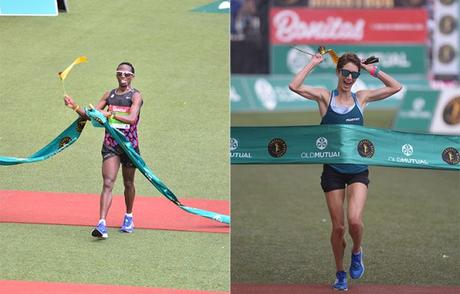
Comrades champions Bongmusa Mthembu and Ann Ashworth led the way for South Africa (photo: Jetline Action Photo)
I’ve gotten the question several times now: Which direction do I prefer, the up run or the down run? And the honest answer is, both and neither. Because there’s so much more to this race than the placement and gradient of the hills.
On the one hand, given the amount of downhill in the second half, the down run is traditionally a faster course (Lindsey Parry agrees). If I were ever to seriously consider a run at a sub-9 hour finish and Bill Rowan medal, I’d do it on the down run. I also met a handful of Comrades veterans whose only successful finishes have been on the down run, along with several unsuccessful attempts at the up run. (I’ve yet to hear of the reverse happening.) If you’re a slower runner who’s concerned with beating the 12-hour cutoff, I’d recommend the down run.
On the other hand, the down run is consistently 3-ish km longer (89 vs 86) than the up run, and will punish your quads and calves if you haven’t adequately trained for downhill running. By the midway point of this year’s down run, my legs definitely felt more fatigued than they had after the first 43 km of climbing last year. So if your strength (like mine) is uphill running, the up run may be your best bet.
That evening, despite our sadly limited appetites, Rory generously hosted dinner at the Japanese restaurant in our hotel. Dining at a nearby table, Bruce Fordyce dropped by to say hello and shake Jimmy’s hand in recognition of an excellent performance in his first Comrades. It was a singular moment and, together with dinner itself, a perfect ending to a day I didn’t want to end. Because it’s not often you earn a personal congratulations from one of the planet’s greatest athletes, amirite?
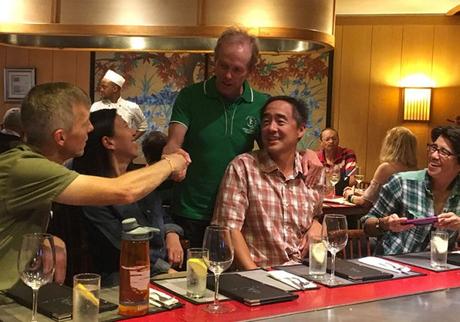
Nine-time Comrades champ Bruce Fordyce congratulates Jimmy on a race well run, while I steal a handshake
Turns out our day wasn’t quite over — or at least not our night. With wire cutters in hand, Katie and I drove the darkened streets around Moses Mabhida Stadium, snipping yellow Comrades “ROUTE CLOSURE” placard from lamp posts to keep and distribute as souvenirs. (I’d secured my matching 2017 placard, signed by both Bruce and 1982 women’s champ/current CMA Chairperson Cheryl Winn, via a charitable donation at the International Runners Reception.) The street crews were happy for the help, since they planned to remove the signs within the week anyway.
[Comrades Tip #8: Want a cool unofficial souvenir? If you have a car, on the night of the race borrow a set of wire cutters (we got ours from the hotel) and go snip one of the yellow Comrades “ROUTE CLOSURE” placards that are affixed to lamp posts along the route. This also helps with post-race clean-up.]
Amazingly, come Monday morning my legs were minimally sore, and even that low-level soreness faded by Wednesday. Either I hadn’t run hard enough, or I’d training my quads well for the downhill pounding — or maybe both. As usual after a tough marathon or ultra, though, my immune system was the real casualty. Over the course of the next week I developed a nasty cold and cough, just in time for back-to-back 11+ hour return flights from Johannesburg to London and London to Los Angeles.
Having crossed finish lines in both Pietermaritzburg (up run) and Durban (down run), I can now say by any standard that I’ve completed the Comrades Marathon. And I’m not exaggerating when I say there’s nothing else like it in the world. It certainly isn’t the most scenic event — there are many more picturesque courses including South Africa’s own Two Oceans Marathon, which bills itself as the “World’s Most Beautiful Marathon.” But it’s hands-down the best, owing to its epic scope — its 93 years of history, its uniquely time-honored traditions, its diverse brotherhood of runners from around the globe, and its cultural and spiritual significance to an entire nation that has fought long and hard to embody the values of dignity, respect and equality that are the cornerstones of the Ultimate Human Race.
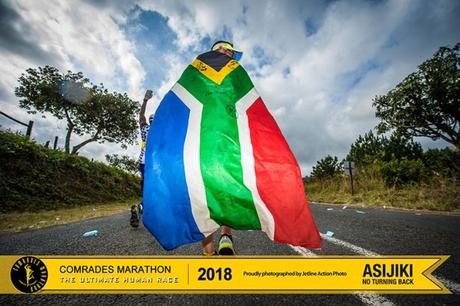
Bruce Fordyce has said that “If you don’t shed at least one tear during Comrades, you must have ice in your veins.” He may be right. But even if you’re not the misty-eyed sentimental type, you’ll never be the same once you’ve experienced this event for yourself. And my suggestion for next year’s race slogan would simply be Liyakushintsha, from the Zulu meaning, It changes you.
Though unthinkable a year ago, the truth is that this year’s sequel more than lived up to the original. This was in large part thanks to the excellent companionship of Jimmy, Cath, Beth and Miguel, plus the excellent returning companionship of John and Rochene from Anchorage and other friendships renewed and forged throughout the weekend. The only thing better than competing in the Ultimate Human Race may be sharing the experience with someone else.
Because while the 90 km marathon may be the focus of the weekend, and rightfully so, this race is all about the comrades.

U-S-A! Ca-na-da! U-S-A!
Comrades Marathon resources I leaned on (in addition to Rory):
- Lindsey Parry’s podcast “RUN with Coach Parry”—especially its archives—is a treasure trove of expertise and insights from the official Comrades coach; older episodes are less than ten minutes each, so you can listen to several at a time. Coach Parry also has some very good content on YouTube.
- Bruce Fordyce’s blog is another invaluable source of tips & tricks. And though I’ve not read them myself, both volumes of his “Fordyce Diaries”—Conquering the Up as well as Tackling a Down Run—are available as e-books exclusively on the site. If anyone can teach you to conquer Comrades, it’s the man who won it nine times!
- Though we planned our own itinerary this year, our friends at Marathon Tours & Travel helped out with logistics, flights and lodging for Comrades 2017 and for our post-race travels in South Africa.
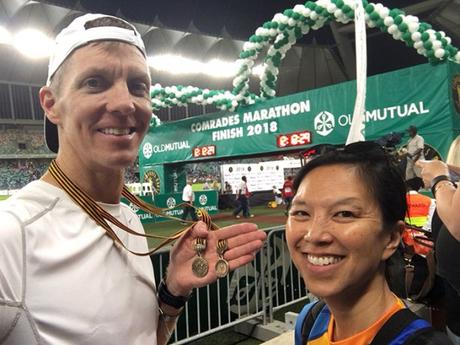
BOTTOM LINE: At the risk of sounding like a (happily) broken record, the Comrades Marathon is the greatest running event on the planet. Not only is it the oldest and largest ultramarathon in the world, but no other event can match its epic scope and time-honored traditions, its all-day adrenaline, and the easy camaraderie forged among runners from around the globe. Comrades is truly a race that celebrates all runners and wants everyone to succeed, from international runners who travel halfway around the world to local runners who qualify for the race but can’t afford lodging — for these athletes, the Comrades Marathon Association (CMA) sets up cots to sleep on near the start line the night before the race.
But to whom much is given — in this case, the opportunity to participate in the Ultimate Human Race — much is expected, and you can expect the journey from Pietermaritzburg to Durban (or the reverse) to be anything but smooth. Because Comrades is a trial by fire. Both mental and physical hardships await on the long, hot, hilly road to Durban, each of which will test you, test your resolve, and ultimately change you. As the 2016 race slogan predicted, Izokuthoba: It will humble you. And if you’re anything like me or the many other runners from around the world who return to this event year after year, you’ll discover that 90 km cycle of destruction and renewal to be cathartic and even downright addictive — physically, spiritually and psychologically. You’ve been warned.
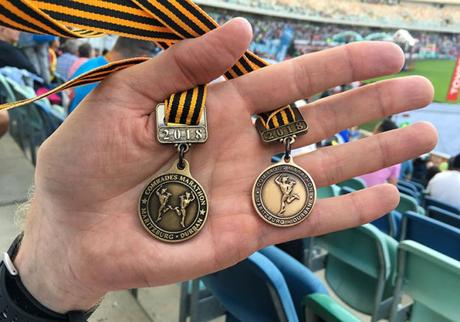
PRODUCTION: Awesome, except for the post-race logistics in Moses Mabhida Stadium, which despite its sleek modernity was less runner-friendly than the smaller Scottsville Racecourse last year. I won’t be the first or last person to tell the CMA that the stadium as a finish venue is a work in progress. Whereas its grandeur and spectator-friendly viewing arrangement are beyond reproach, as a post-race recovery zone for runners it leaves a lot to be desired.
There’s plenty of work to be done to reimagine Moses Mabhida as a more comfortable and inviting post-race venue, and hopefully that starts with letting finishers and running clubs gather on the grass playing field. While I’d imagine there are liability and security issues that limit its access, it seems absurd to have exhausted runners dragging themselves up and down concrete stairs, sitting in cramped plastic seats and sprawling underfoot on the floor of the concourse while an immaculate grass surface lays unused below them.
Aside from that, race day was perfect. And a special shout-out of appreciation to all the volunteers without whom Comrades would be impossible — I’m constantly amazed at the selflessness of the folks who voluntarily stand on their feet for hours in any weather to help runners like me achieve our personal goals. You all are the real heroes of the Comrades Marathon!
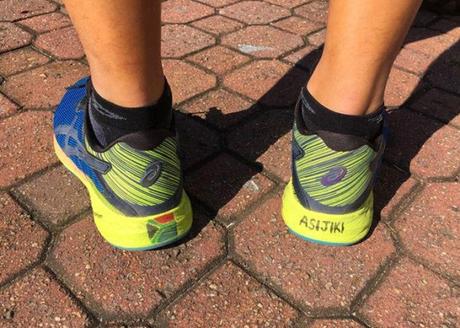
Appropriately, Jimmy’s shoes get the last word
SWAG: At roughly the size of an American quarter or RSA 5 Rand coin (the back-to-back medal is only modestly larger), the Comrades finisher medal may be the smallest in distance running. And yet it’s also among the most coveted. My three Comrades medals — two bronze, one back-to-back for running consecutive years — are the guests of honor in my collection alongside my Boston Marathon unicorn. To me, the medals are beautiful in their simplicity. Plus, they’re great conversation starters, particularly for puzzled non-runners who balk at the notion of running 90 km for something that small.
Unfortunately, the official race shirt this year was downright ugly. As Jimmy suggested, it’s almost as if Mizuno learned they’d won the Comrades sponsorship and immediately sent someone into the back of the warehouse to find a bunch of blank tech shirts on which to print a Comrades logo, year and distance. The royal blue shirt has the beginnings of a honeycomb pattern on front which morphs into a strange geometric pattern reminiscent — to this lab rat — of viruses viewed under an electron micropscope. All of which adds nothing to the design. The shirt lacks the design sensibility of last year’s New Balance merch, a truth that extended to everything in the Mizuno store at this year’s expo. I showed up at the expo ready to support all things Comrades as I had in 2017, only to be disappointed by Mizuno running shoes with no Comrades branding and Mizuno t-shirts that simply said “Osaka Japan” on the front. In the end, I grudgingly saved my money and opted for a simple black tech shirt with a tiny Comrades logo on the sleeve. So a word to the wise at Mizuno: get back to the drawing board before next year’s event and KNOW YOUR AUDIENCE. You could sell hella more merch with even the slightest bit of foresight and design sensibility.
(Huge thanks to Cath, Katie and Miguel, without whose photos I couldn’t have filled up a 13,000-word race report!)
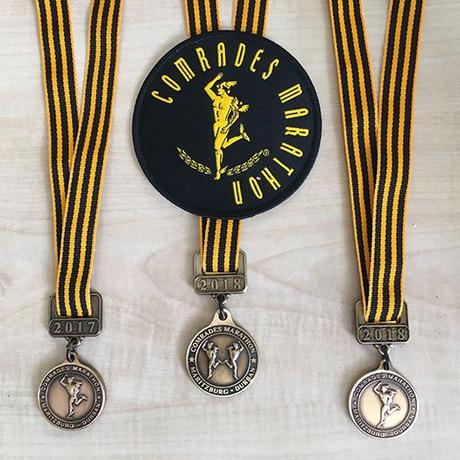
RaceRaves rating:
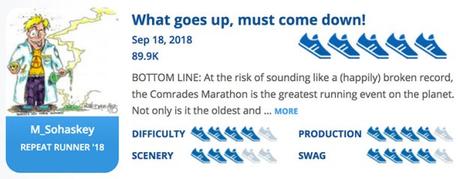
FINAL STATS:
Jun 10, 2018 (start time 5:30 am, sunrise 6:49 am)
56.58 miles (91.1 km, officially 90.184 km) from Pietermaritzburg to Durban, South Africa
Finish time & pace: 9:48:25 (second time running Comrades, first “down” run), 10:24/mile
Finish place: 4,957 overall, 1,760/5,710 in M 40-49 age group
Number of finishers: 16,478 total (78% men, 22% women)
Race weather: cool (57°F) & partly cloud at the start, warm (72°F) and partly cloudy at the finish, overcast throughout the race
Elevation change (Garmin Connect): 4,024 ft ascent, 6,134 ft descent
Elevation min, max: 20 ft, 2,710 ft

